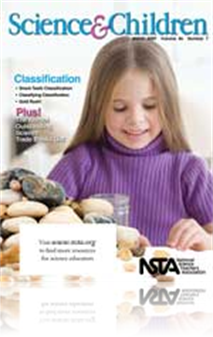All Science and Children resources
Journal Article
Editor’s Note: Classification Matters
Classification skills, so foundational to science, must be taught. While children have a passion and drive to organize and categorize their experiences, sometimes the way they organize them doesn’t lead to a worthwhile or accurate scientific unders...
Journal Article
The Early Years: Does Light Go Through It?
Words give us the power to describe our world and how we experience it. Any time we classify something, we give it a name to distinguish it from all others of its kind. Like the buttons on a kitchen blender which says “mix” in five or six differe...
Journal Article
An after-school science class on properties teaches students “all that glitters is not gold.” Through this gold panning simulation, students analyze the properties of pyrite, or “Fool’s Gold,” and discover the importance of properties to e...
Journal Article
Methods and Strategies: The Home Connection
Teachers can help students gain experience in the natural world by taking students outside, but such experiences usually have tight time constraints due to elementary students’ very busy daily school schedules. Another important, yet often overlook...
Journal Article
Outstanding Science Trade Books for Students K–12 (Books published in 2008)
Today’s classrooms have no real walls! Students explore the world on field trips, during virtual journeys on the world wide web, and through the books they read. These pathways help them fly to the ends of the universe to satisfy their scientific c...
Journal Article
Science 101: What makes a curveball curve?
Ah, springtime, and young people’s thoughts turn to … baseball, of course. But this column is not about how to throw a curveball, so you’ll have to look that up on your own. Here the focus is on the why of the curveball. There are two different...
Journal Article
Science 101: Do plants communicate?
Oh yes. Sometimes their conversation is flowery, sometimes not. Plants with problems try to converse and get to the root of the problem, but if not, they have been known to stalk one another. This often creates a situation where one plant leaves town...
Journal Article
When it comes to directly interacting with and doing experiments with organisms, plants have some distinct advantages over animals. Their diversity and accessibility allows students to use them in experiments, thus practicing important science inquir...
Journal Article
Science Shorts: Hypothesis Testing—It’s Okay to Be Wrong
Students often seek affirmation from their teachers about their thinking and can be embarrassed at the thought of being “wrong.” In science, we want children to feel comfortable making hypotheses and to know that it’s the investigative process�...
Journal Article
From Cookbook to Experimental Design
Developing expertise, whether from cook to chef or from student to scientist, occurs over time and requires encouragement, guidance, and support. One key goal of an elementary science program should be to move students toward expertise in their abili...
Journal Article
In the process of discovering the extraordinary creature commonly known as a red wiggler worm—or as scientists would identify it, Eisenia fetida, fifth-grade students recycled their school lunch leftovers, made predictions about worm behavior in co...





